Abstract
Investigation of urinary markers as indices of endogenous nitrosation and of gastric cancer etiology has been a major focus of our work. As part of this effort, studies have been carried out on a Colombian population at high risk for gastric cancer. In this group, nitrosoproline excretion was highly correlated with nitrate excretion in the subpopulation with advanced gastric pathology, but not in control subpopulations with more normal stomachs. Neither urinary 7-methylguanine nor 3-methyladenine was strongly related to gastric pathology or to urinary nitrate or nitrosoproline levels. More recently, as evidence has accumulated concerning the importance of nitric oxide as a cellular messenger, we have begun research toward developing markers for the presence of nitric oxide and for endogenous nitrosation via this compound. Nitric oxide is formed from arginine by activated endothelial cells as a messenger for vasodilation. We have shown that prolonged exercise leads to increased urinary nitrate and that when 15N-arginine is ingested by humans, 15N-nitrate levels increase in 24-hr urine collections. Nitrosohydroxyethylglycine and 3-nitrotyrosine were evaluated as indices for the formation of N-nitrosomorpholine and for the nitration of protein, respectively, under experimental conditions (e.g., immunostimulation) expected to enhance nitric oxide formation. Nitrotyrosine has not proved useful as a biomarker for nitration/nitrosation reactions in immunostimulated rats. Immunostimulation of rats following administration of morpholine led to increases in urinary nitrate and nitrosohydroxyethylglycine. This procedure, however, would not be appropriate for humans due to the toxicity of morpholine and the carcinogenicity of N-nitrosomorpholine.
Full text
PDF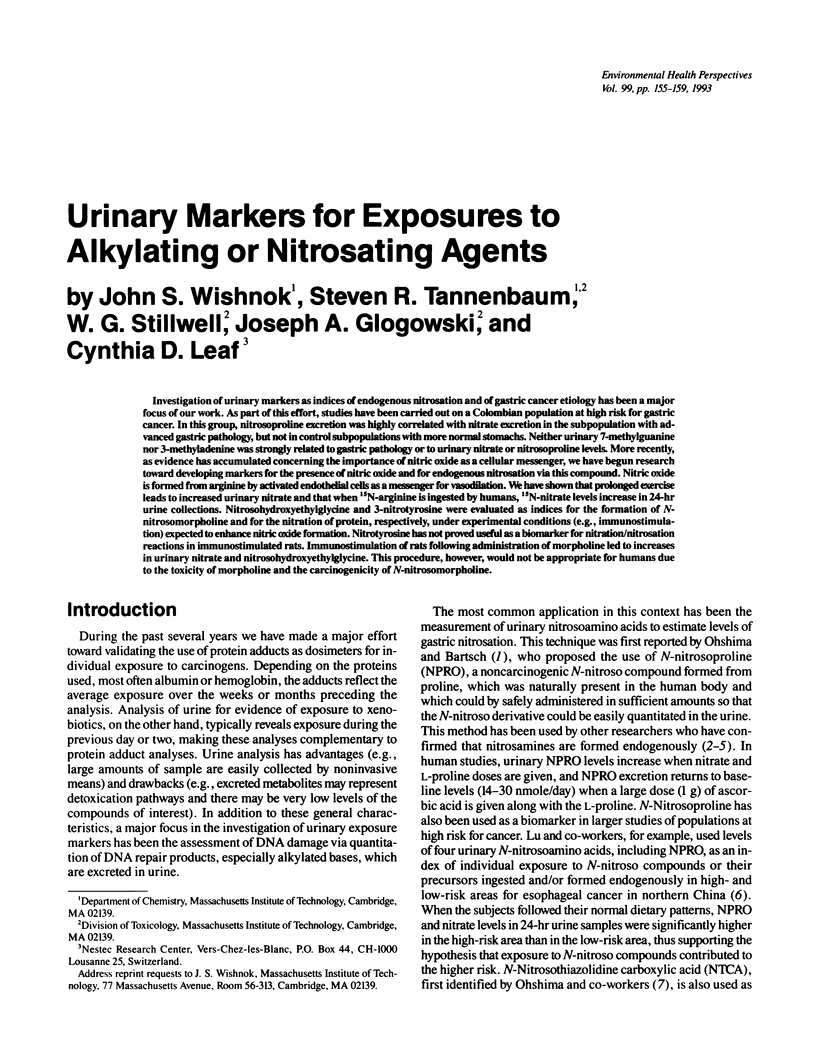
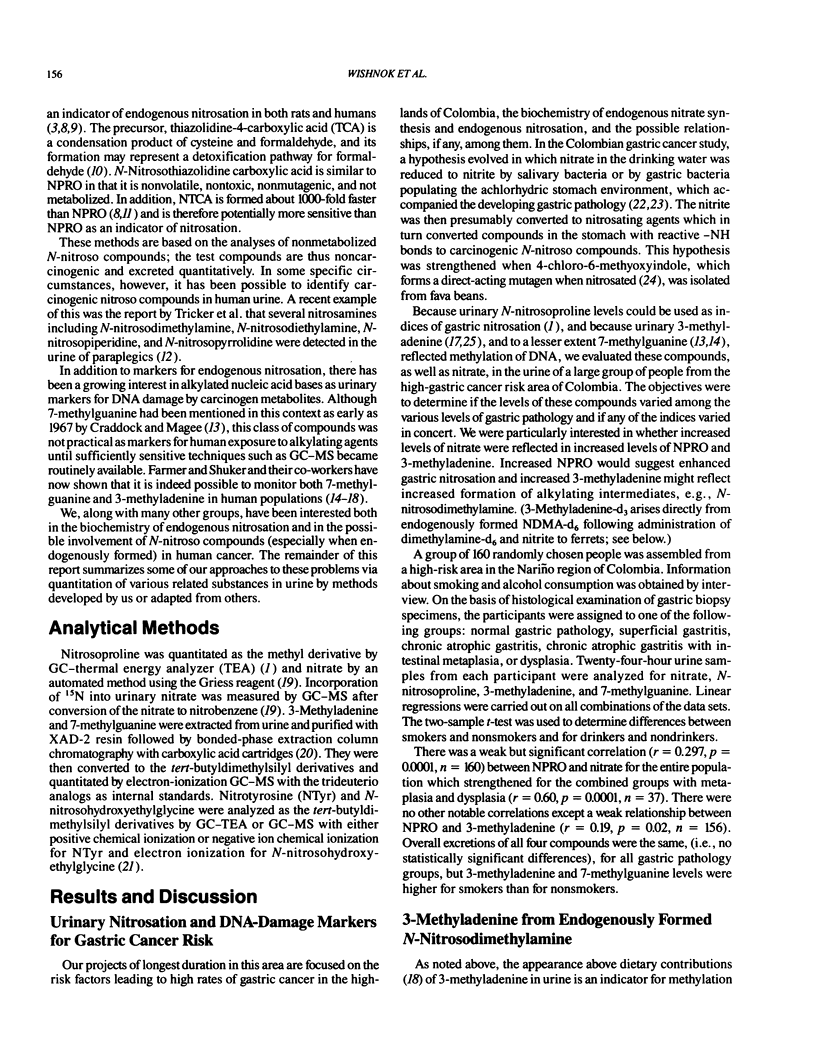
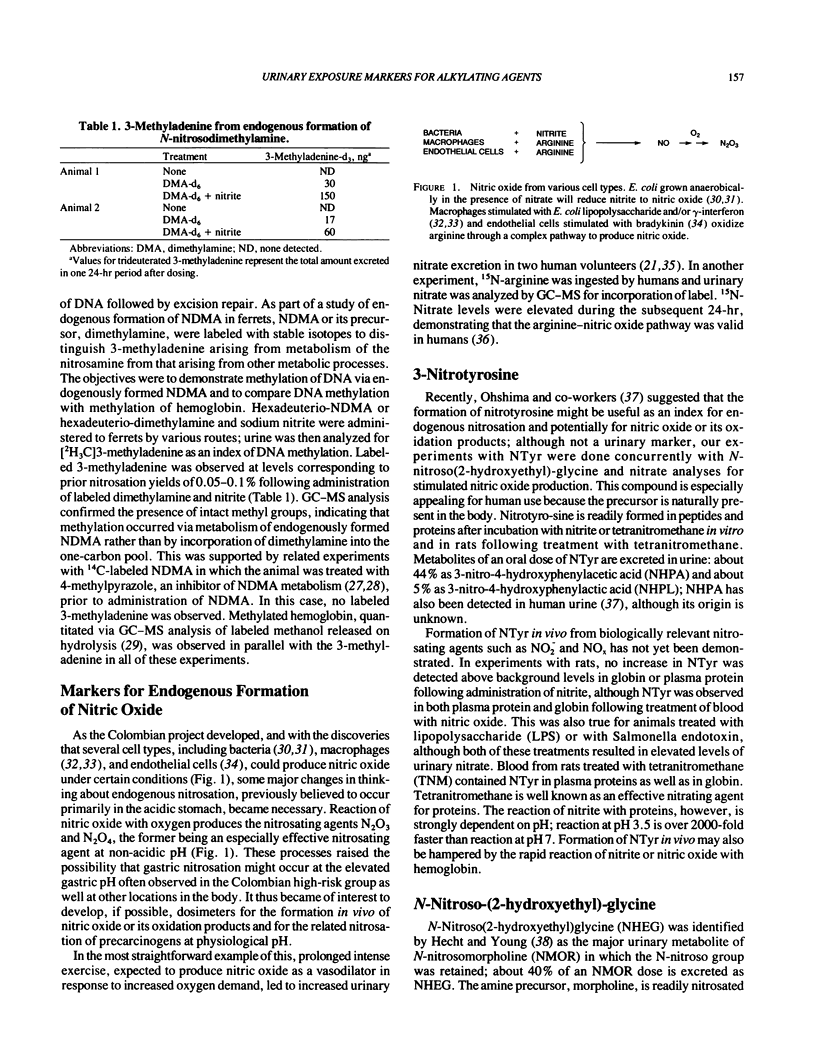
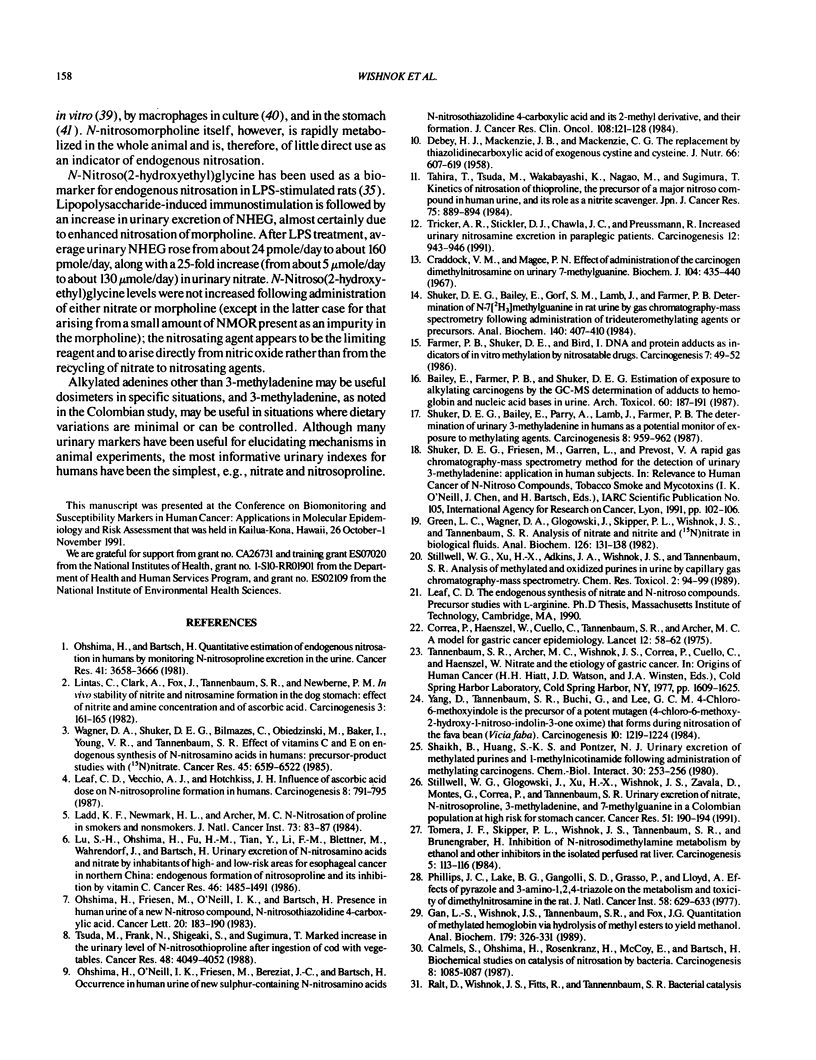
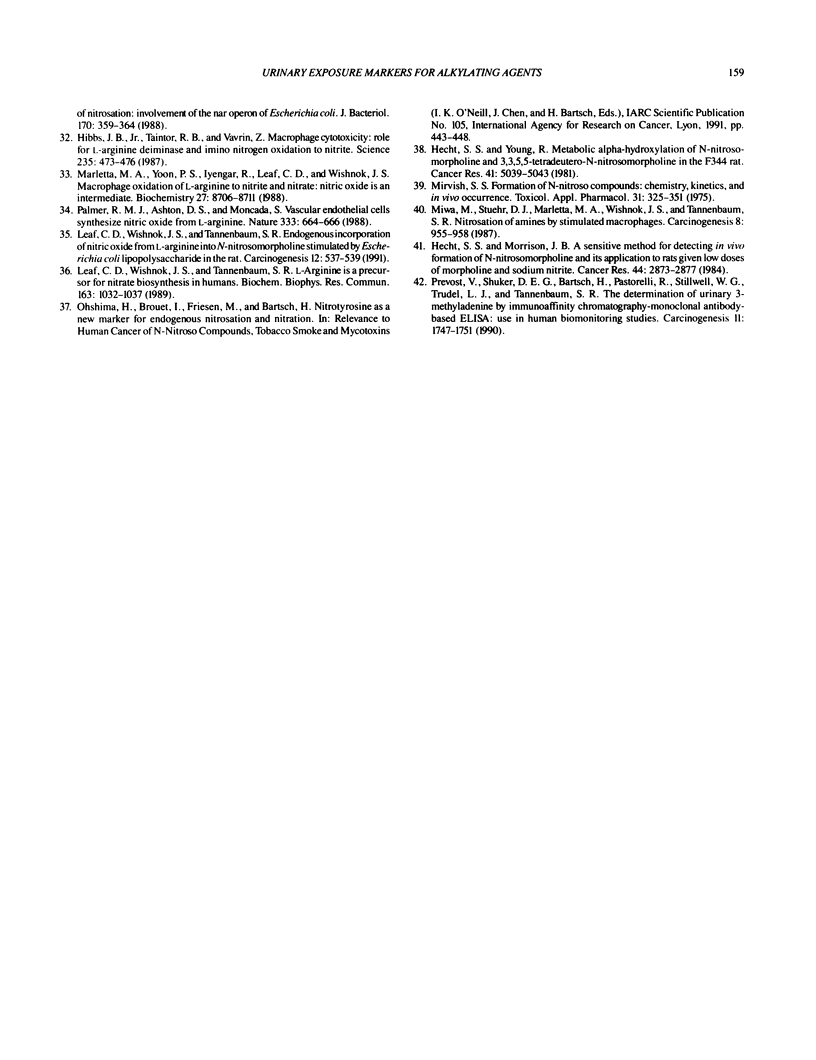
Selected References
These references are in PubMed. This may not be the complete list of references from this article.
- Bailey E., Farmer P. B., Shuker D. E. Estimation of exposure to alkylating carcinogens by the GC-MS determination of adducts to hemoglobin and nucleic acid bases in urine. Arch Toxicol. 1987;60(1-3):187–191. doi: 10.1007/BF00296978. [DOI] [PubMed] [Google Scholar]
- Calmels S., Ohshima H., Rosenkranz H., McCoy E., Bartsch H. Biochemical studies on the catalysis of nitrosation by bacteria. Carcinogenesis. 1987 Aug;8(8):1085–1088. doi: 10.1093/carcin/8.8.1085. [DOI] [PubMed] [Google Scholar]
- Craddock V. M., Magee P. N. Effect of administration of the carcinogen dimethylnitrosamine on urinary 7-methylguanine. Biochem J. 1967 Aug;104(2):435–440. doi: 10.1042/bj1040435. [DOI] [PMC free article] [PubMed] [Google Scholar]
- DEBEY H. J., MACKENZIE J. B., MACKENZIE C. G. The replacement by thiazolidinecarboxylic acid of exogenous cystine and cysteine. J Nutr. 1958 Dec 10;66(4):607–619. doi: 10.1093/jn/66.4.607. [DOI] [PubMed] [Google Scholar]
- Farmer P. B., Shuker E. G., Bird I. DNA and protein adducts as indicators of in vivo methylation by nitrosatable drugs. Carcinogenesis. 1986 Jan;7(1):49–52. doi: 10.1093/carcin/7.1.49. [DOI] [PubMed] [Google Scholar]
- Gan L. S., Wishnok J. S., Fox J. G., Tannenbaum S. R. Quantitation of methylated hemoglobin via hydrolysis of methyl esters to yield methanol. Anal Biochem. 1989 Jun;179(2):326–331. doi: 10.1016/0003-2697(89)90137-1. [DOI] [PubMed] [Google Scholar]
- Green L. C., Wagner D. A., Glogowski J., Skipper P. L., Wishnok J. S., Tannenbaum S. R. Analysis of nitrate, nitrite, and [15N]nitrate in biological fluids. Anal Biochem. 1982 Oct;126(1):131–138. doi: 10.1016/0003-2697(82)90118-x. [DOI] [PubMed] [Google Scholar]
- Hecht S. S., Morrison J. B. A sensitive method for detecting in vivo formation of N-nitrosomorpholine and its application to rats given low doses of morpholine and sodium nitrite. Cancer Res. 1984 Jul;44(7):2873–2877. [PubMed] [Google Scholar]
- Hecht S. S., Young R. Metabolic alpha-hydroxylation of N-nitrosomorpholine and 3,3,5,5-tetradeutero-N-nitrosomorpholine in the F344 rat. Cancer Res. 1981 Dec;41(12 Pt 1):5039–5043. [PubMed] [Google Scholar]
- Hibbs J. B., Jr, Taintor R. R., Vavrin Z. Macrophage cytotoxicity: role for L-arginine deiminase and imino nitrogen oxidation to nitrite. Science. 1987 Jan 23;235(4787):473–476. doi: 10.1126/science.2432665. [DOI] [PubMed] [Google Scholar]
- Ladd K. F., Newmark H. L., Archer M. C. N-nitrosation of proline in smokers and nonsmokers. J Natl Cancer Inst. 1984 Jul;73(1):83–87. [PubMed] [Google Scholar]
- Leaf C. D., Vecchio A. J., Roe D. A., Hotchkiss J. H. Influence of ascorbic acid dose on N-nitrosoproline formation in humans. Carcinogenesis. 1987 Jun;8(6):791–795. doi: 10.1093/carcin/8.6.791. [DOI] [PubMed] [Google Scholar]
- Leaf C. D., Wishnok J. S., Tannenbaum S. R. Endogenous incorporation of nitric oxide from L-arginine into N-nitrosomorpholine stimulated by Escherichia coli lipopolysaccharide in the rat. Carcinogenesis. 1991 Mar;12(3):537–539. doi: 10.1093/carcin/12.3.537. [DOI] [PubMed] [Google Scholar]
- Leaf C. D., Wishnok J. S., Tannenbaum S. R. L-arginine is a precursor for nitrate biosynthesis in humans. Biochem Biophys Res Commun. 1989 Sep 15;163(2):1032–1037. doi: 10.1016/0006-291x(89)92325-5. [DOI] [PubMed] [Google Scholar]
- Lintas C. L., Clark A., Fox J., Tannenbaum S. R., Newberne P. M. In vivo stability of nitrite and nitrosamine formation in the dog stomach: effect of nitrite and amine concentration and of ascorbic acid. Carcinogenesis. 1982;3(2):161–165. doi: 10.1093/carcin/3.2.161. [DOI] [PubMed] [Google Scholar]
- Lu S. H., Ohshima H., Fu H. M., Tian Y., Li F. M., Blettner M., Wahrendorf J., Bartsch H. Urinary excretion of N-nitrosamino acids and nitrate by inhabitants of high- and low-risk areas for esophageal cancer in Northern China: endogenous formation of nitrosoproline and its inhibition by vitamin C. Cancer Res. 1986 Mar;46(3):1485–1491. [PubMed] [Google Scholar]
- Marletta M. A., Yoon P. S., Iyengar R., Leaf C. D., Wishnok J. S. Macrophage oxidation of L-arginine to nitrite and nitrate: nitric oxide is an intermediate. Biochemistry. 1988 Nov 29;27(24):8706–8711. doi: 10.1021/bi00424a003. [DOI] [PubMed] [Google Scholar]
- Mirvish S. S. Formation of N-nitroso compounds: chemistry, kinetics, and in vivo occurrence. Toxicol Appl Pharmacol. 1975 Mar;31(3):325–351. doi: 10.1016/0041-008x(75)90255-0. [DOI] [PubMed] [Google Scholar]
- Miwa M., Stuehr D. J., Marletta M. A., Wishnok J. S., Tannenbaum S. R. Nitrosation of amines by stimulated macrophages. Carcinogenesis. 1987 Jul;8(7):955–958. doi: 10.1093/carcin/8.7.955. [DOI] [PubMed] [Google Scholar]
- Ohshima H., Bartsch H. Quantitative estimation of endogenous nitrosation in humans by monitoring N-nitrosoproline excreted in the urine. Cancer Res. 1981 Sep;41(9 Pt 1):3658–3662. [PubMed] [Google Scholar]
- Ohshima H., Friesen M., O'Neill I., Bartsch H. Presence in human urine of a new N-nitroso compound, N-nitrosothiazolidine 4-carboxylic acid. Cancer Lett. 1983 Sep;20(2):183–190. doi: 10.1016/0304-3835(83)90047-2. [DOI] [PubMed] [Google Scholar]
- Ohshima H., O'Neill I. K., Friesen M., Béréziat J. C., Bartsch H. Occurrence in human urine of new sulphur-containing N-nitrosamino acids N-nitrosothiazolidine 4-carboxylic acid and its 2-methyl derivative, and their formation. J Cancer Res Clin Oncol. 1984;108(1):121–128. doi: 10.1007/BF00390983. [DOI] [PubMed] [Google Scholar]
- Palmer R. M., Ashton D. S., Moncada S. Vascular endothelial cells synthesize nitric oxide from L-arginine. Nature. 1988 Jun 16;333(6174):664–666. doi: 10.1038/333664a0. [DOI] [PubMed] [Google Scholar]
- Phillips J. C., Lake B. G., Gangolli S. D., Grasso P., Lloyd A. G. Effects of pyrazole and 3-amino-1,2,4-triazole on the metabolism and toxicity of dimethylnitrosamine in the rat. J Natl Cancer Inst. 1977 Mar;58(3):629–633. doi: 10.1093/jnci/58.3.629. [DOI] [PubMed] [Google Scholar]
- Prevost V., Shuker D. E., Bartsch H., Pastorelli R., Stillwell W. G., Trudel L. J., Tannenbaum S. R. The determination of urinary 3-methyladenine by immunoaffinity chromatography-monoclonal antibody-based ELISA: use in human biomonitoring studies. Carcinogenesis. 1990 Oct;11(10):1747–1751. doi: 10.1093/carcin/11.10.1747. [DOI] [PubMed] [Google Scholar]
- Shaikh B., Huang S. S., Pontzer N. J. Urinary excretion of methylated purines and 1-methyl-nicotinamide following administration of methylating carcinogens. Chem Biol Interact. 1980 May;30(2):253–256. doi: 10.1016/0009-2797(80)90132-5. [DOI] [PubMed] [Google Scholar]
- Shuker D. E., Bailey E., Parry A., Lamb J., Farmer P. B. The determination of urinary 3-methyladenine in humans as a potential monitor of exposure to methylating agents. Carcinogenesis. 1987 Jul;8(7):959–962. doi: 10.1093/carcin/8.7.959. [DOI] [PubMed] [Google Scholar]
- Stillwell W. G., Glogowski J., Xu H. X., Wishnok J. S., Zavala D., Montes G., Correa P., Tannenbaum S. R. Urinary excretion of nitrate, N-nitrosoproline, 3-methyladenine, and 7-methylguanine in a Colombian population at high risk for stomach cancer. Cancer Res. 1991 Jan 1;51(1):190–194. [PubMed] [Google Scholar]
- Stillwell W. G., Xu H. X., Adkins J. A., Wishnok J. S., Tannenbaum S. R. Analysis of methylated and oxidized purines in urine by capillary gas chromatography-mass spectrometry. Chem Res Toxicol. 1989 Mar-Apr;2(2):94–99. doi: 10.1021/tx00008a004. [DOI] [PubMed] [Google Scholar]
- Tahira T., Tsuda M., Wakabayashi K., Nagao M., Sugimura T. Kinetics of nitrosation of thioproline, the precursor of a major nitroso compound in human urine, and its role as a nitrite scavenger. Gan. 1984 Oct;75(10):889–894. [PubMed] [Google Scholar]
- Tomera J. F., Skipper P. L., Wishnok J. S., Tannenbaum S. R., Brunengraber H. Inhibition of N-nitrosodimethylamine metabolism by ethanol and other inhibitors in the isolated perfused rat liver. Carcinogenesis. 1984 Jan;5(1):113–116. doi: 10.1093/carcin/5.1.113. [DOI] [PubMed] [Google Scholar]
- Tricker A. R., Stickler D. J., Chawla J. C., Preussmann R. Increased urinary nitrosamine excretion in paraplegic patients. Carcinogenesis. 1991 May;12(5):943–946. doi: 10.1093/carcin/12.5.943. [DOI] [PubMed] [Google Scholar]
- Tsuda M., Frank N., Sato S., Sugimura T. Marked increase in the urinary level of N-nitrosothioproline after ingestion of cod with vegetables. Cancer Res. 1988 Jul 15;48(14):4049–4052. [PubMed] [Google Scholar]
- Wagner D. A., Shuker D. E., Bilmazes C., Obiedzinski M., Baker I., Young V. R., Tannenbaum S. R. Effect of vitamins C and E on endogenous synthesis of N-nitrosamino acids in humans: precursor-product studies with [15N]nitrate. Cancer Res. 1985 Dec;45(12 Pt 1):6519–6522. [PubMed] [Google Scholar]


